Image Archive
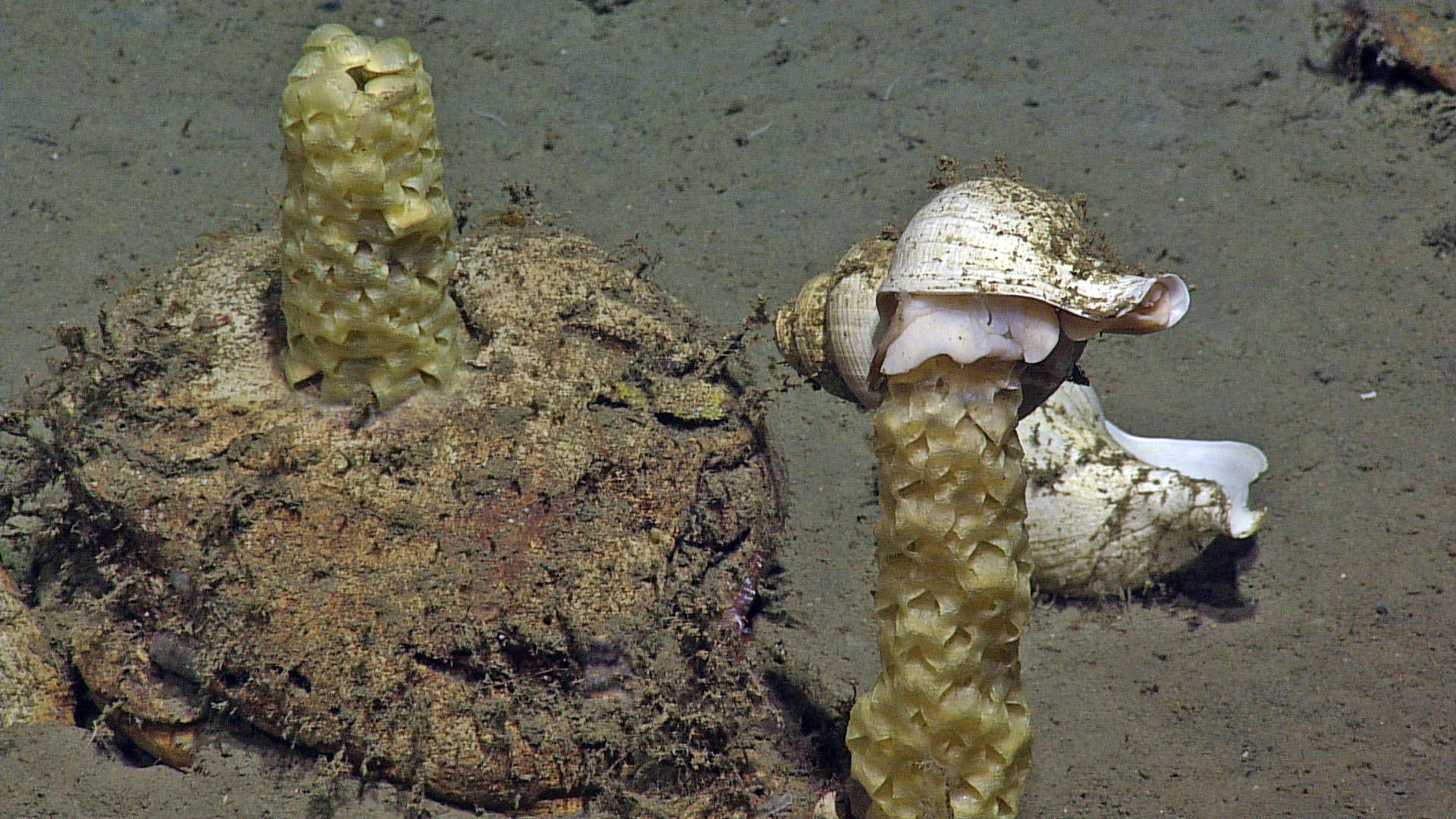
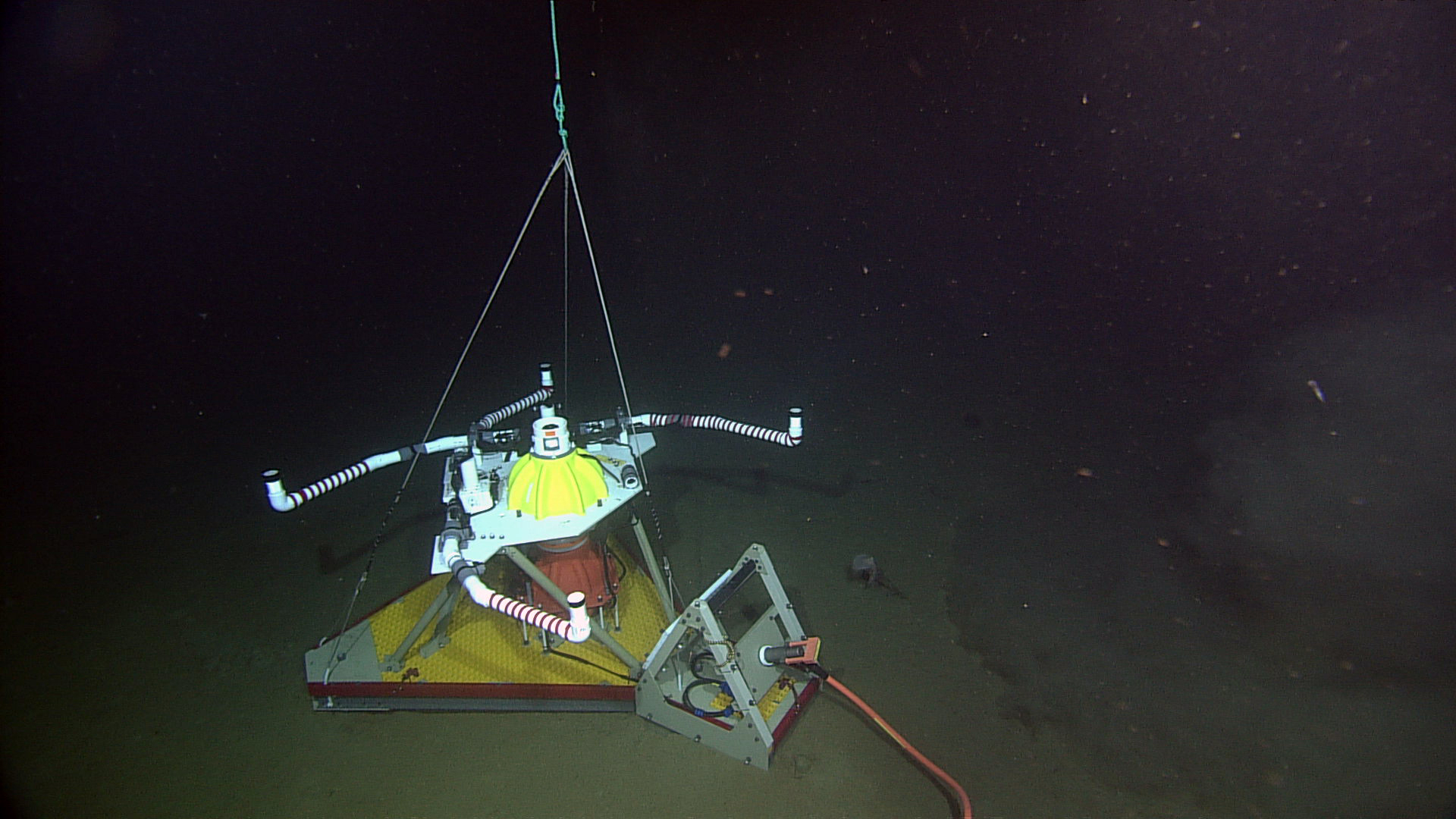
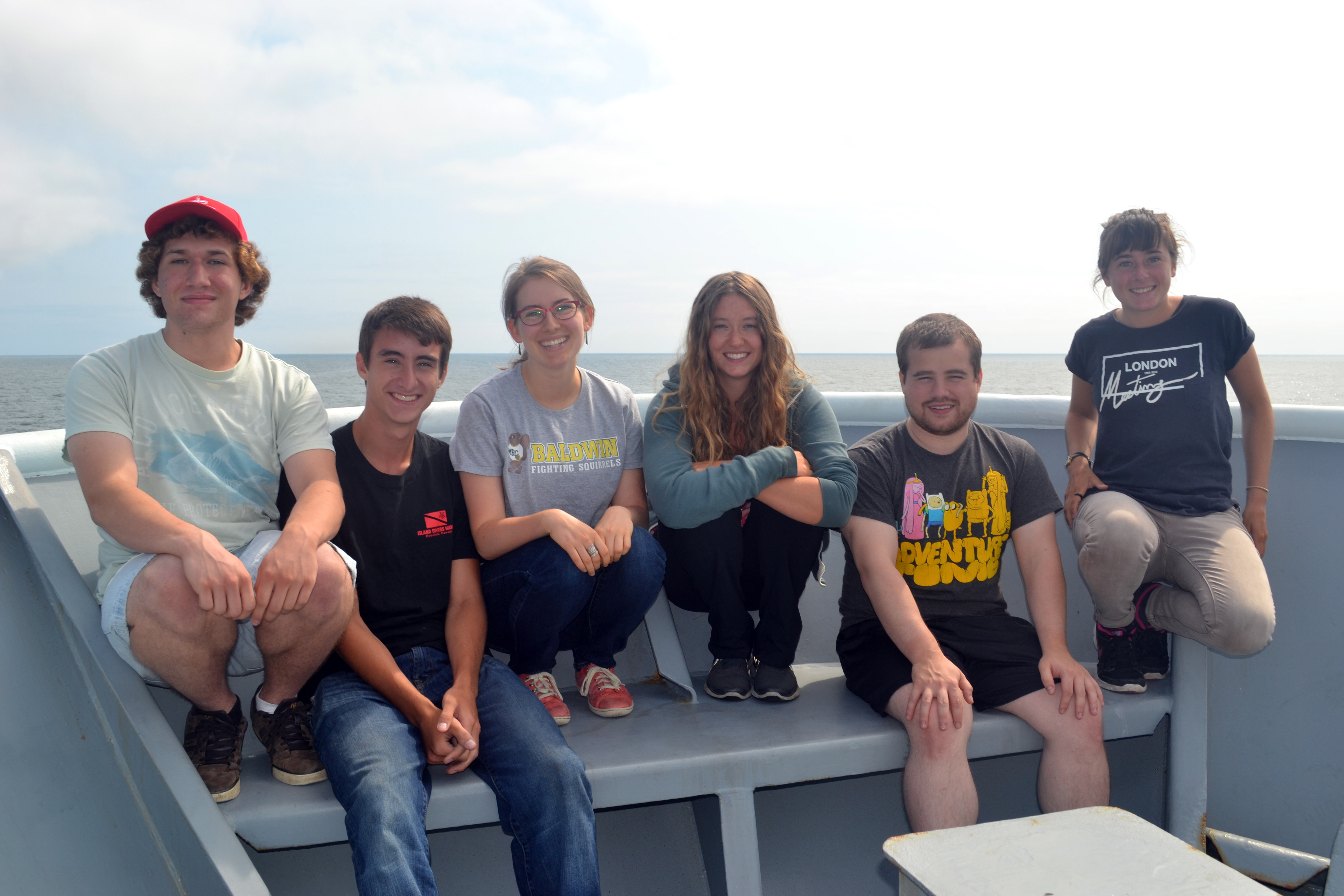
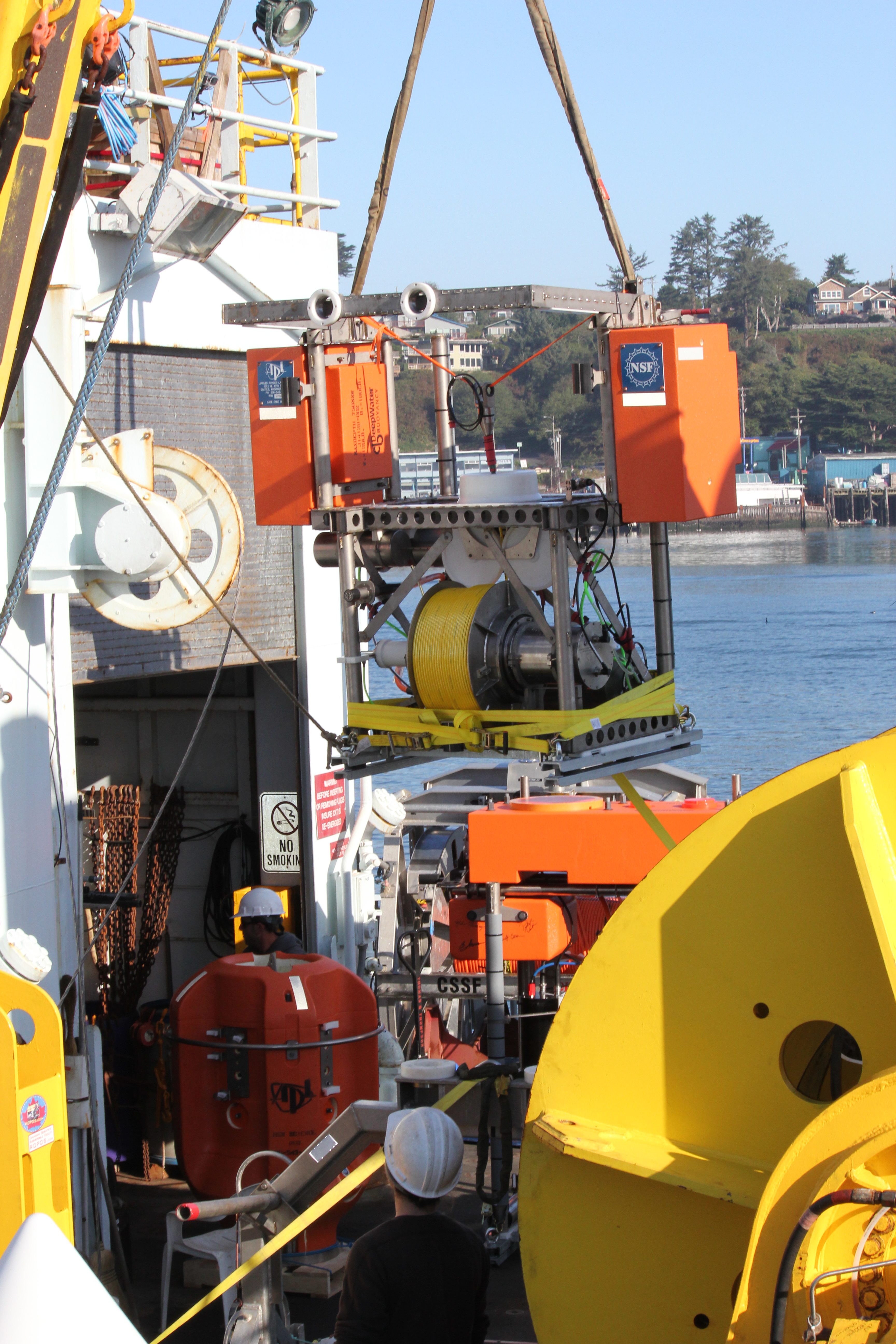

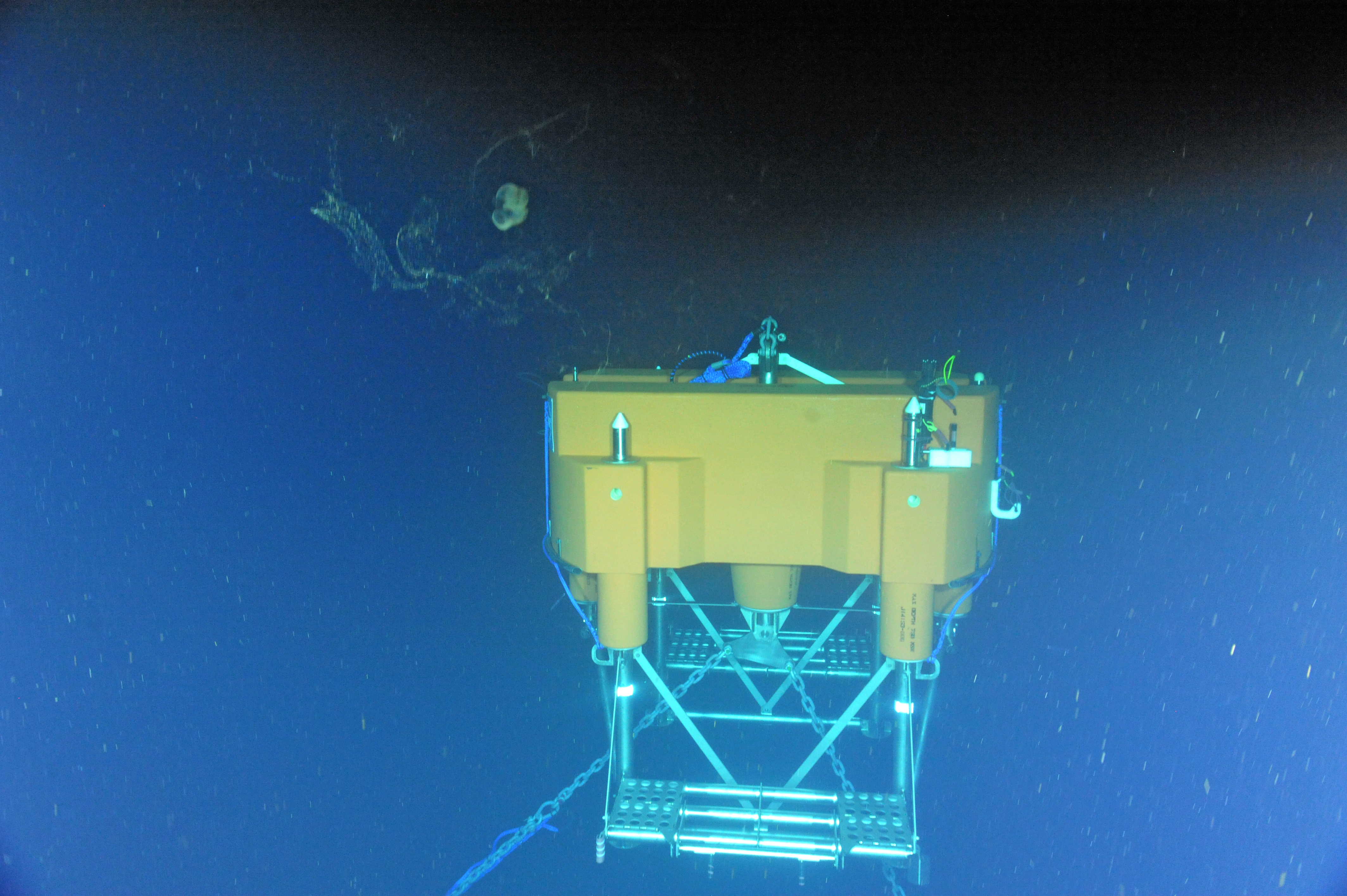

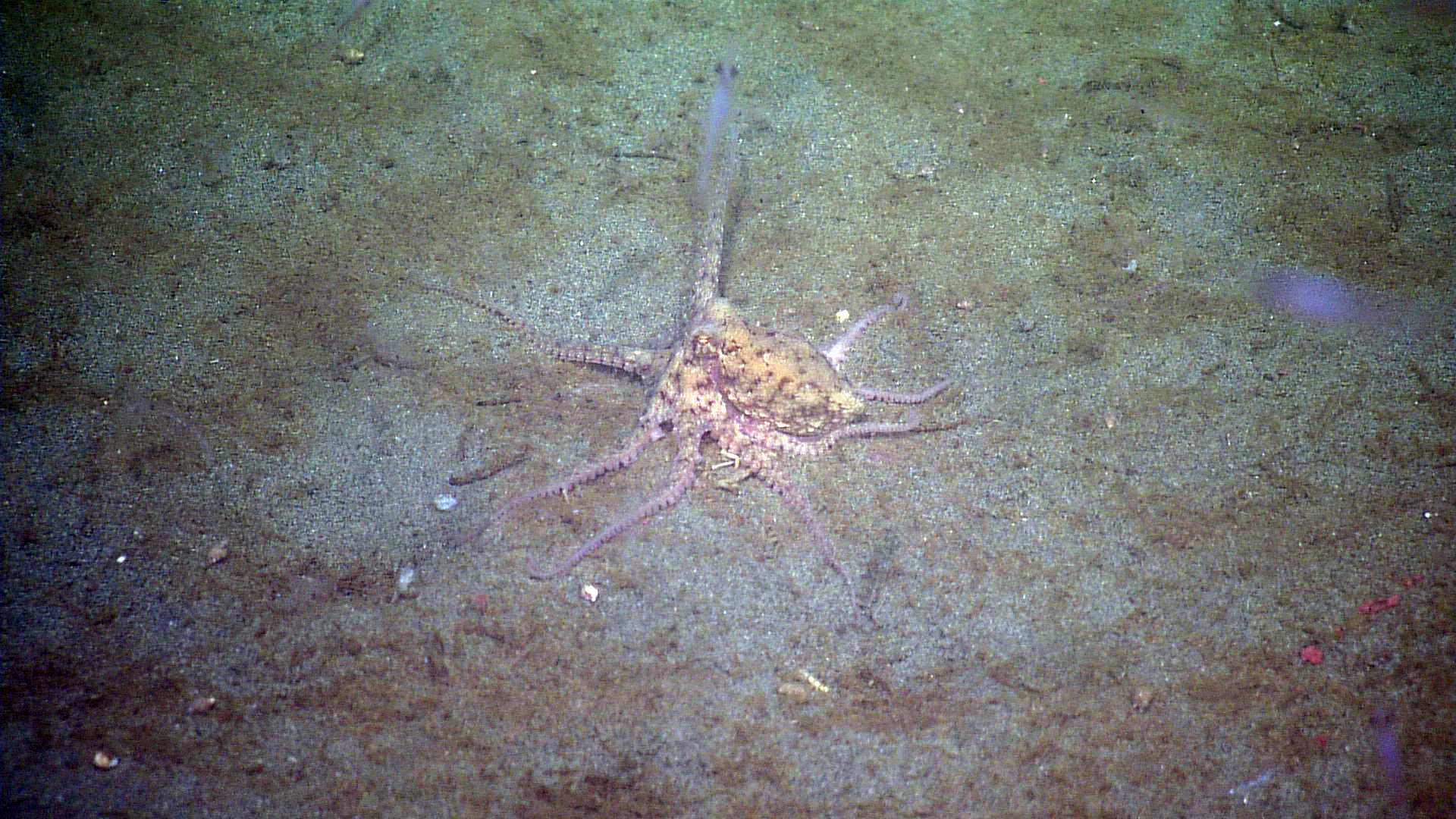
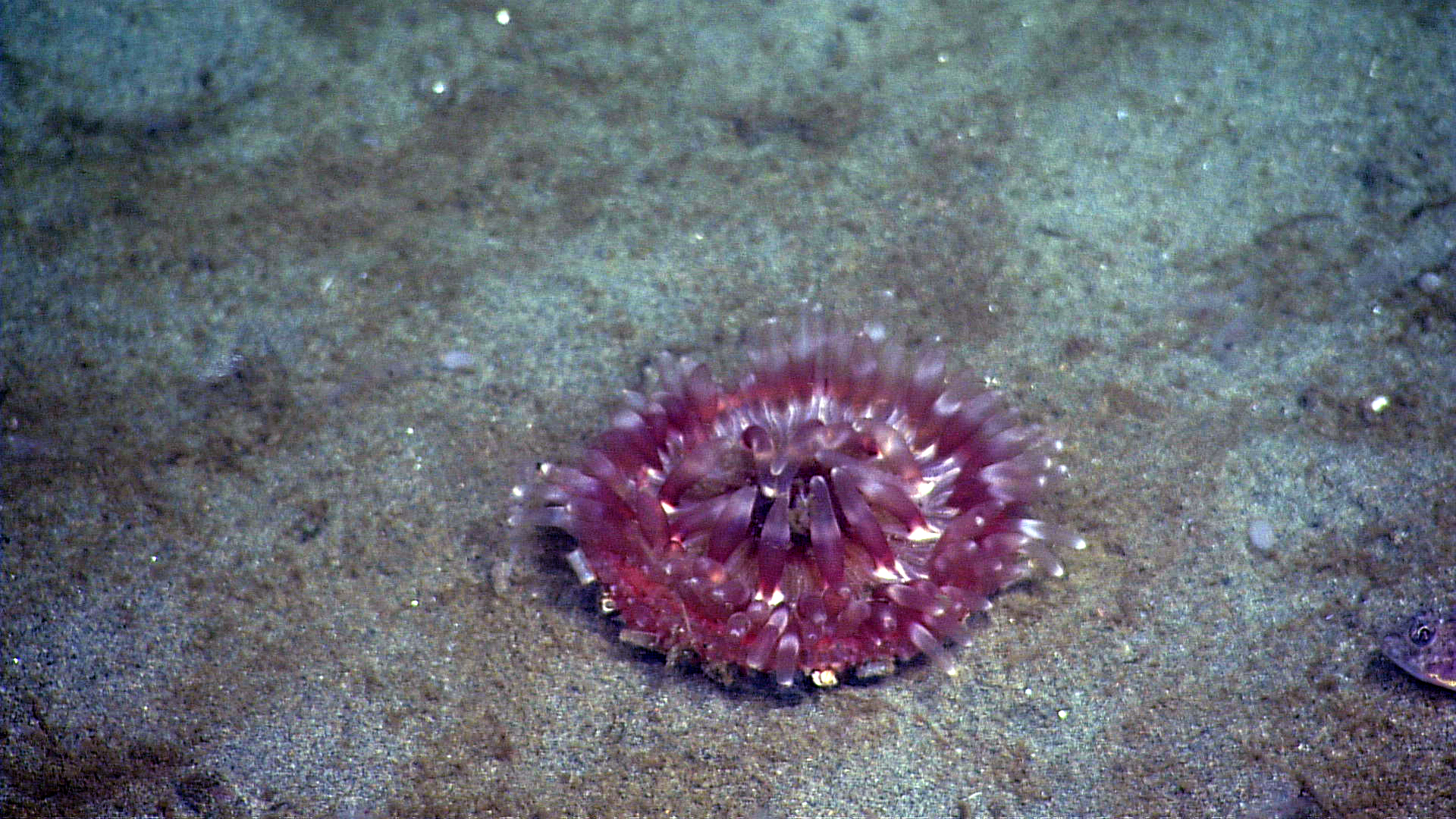






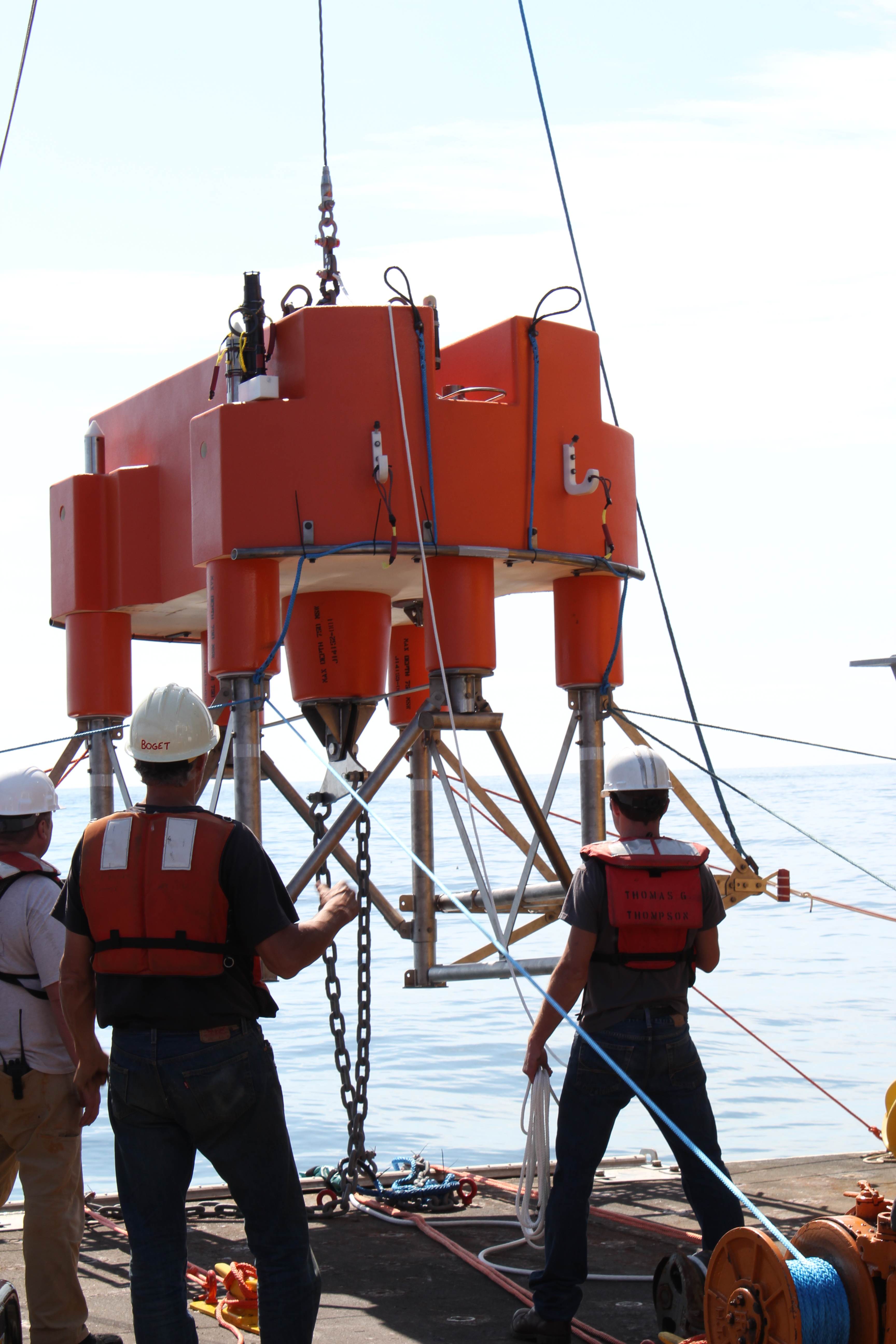









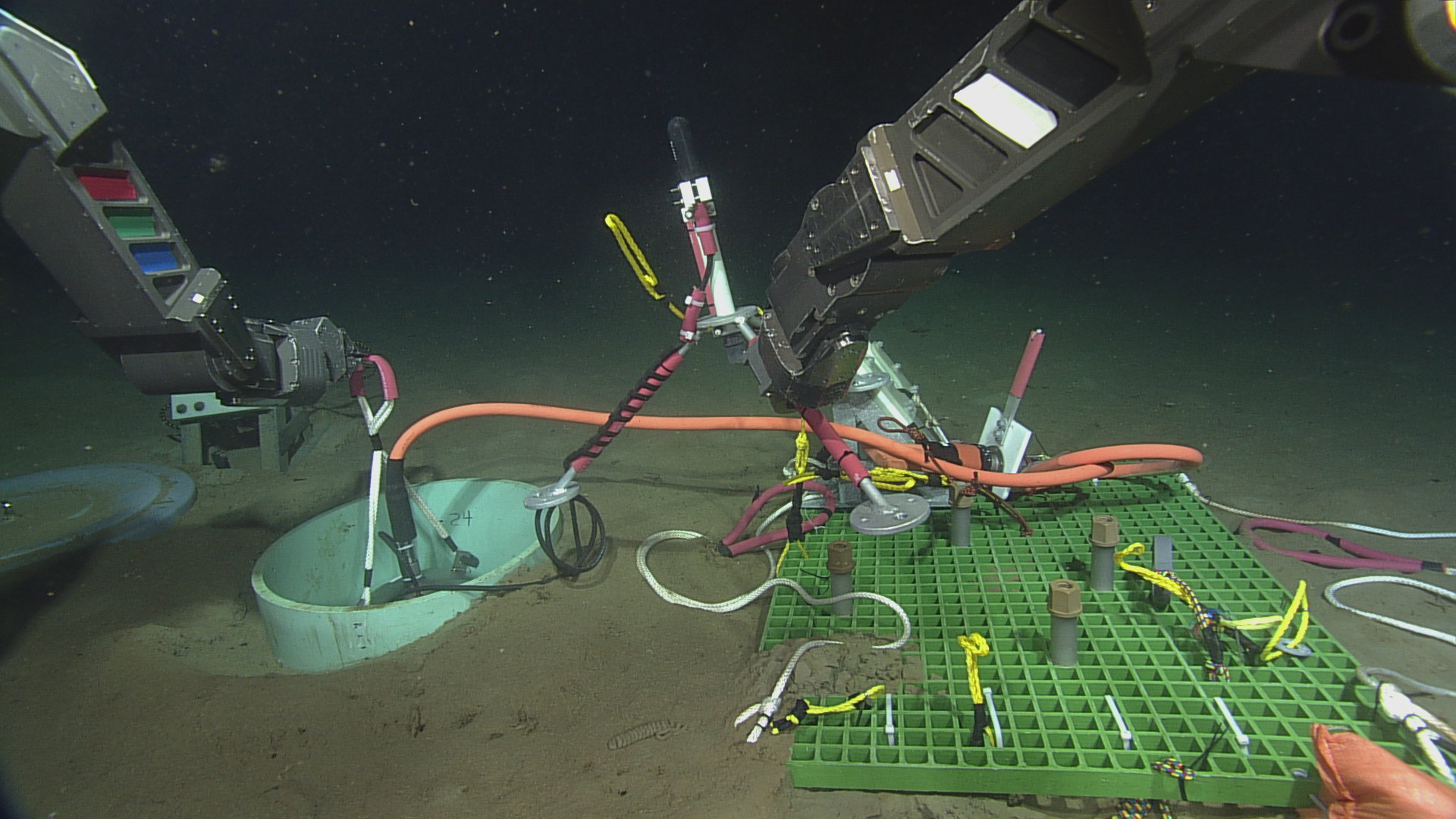


Close up of a Neptunea snail on its egg stalk at the summit of Southern Hydrate Ridge. Credit: UW/NSF-OOI/CSSF; ROPOS Dive R1758; V14.

The Horizontal Electrometer-Pressure-Inverted Echosounder (HPIES -HPIESA101) installed at the Slope Base site. Photo credit: NSF-OOI/UW/CSSF; Dive R1757; V14.

Leg 3 students on the VISIONS'14 Expedition gather on the bow of the R/V Thompson. Photo Credit. Mitch Elend, UW; V14.

During the port call for Leg 4 in Newport, Oregon, the UW-APL-built Shallow Winched Profiler was loaded onto the R/V Thompson. The system has an underwater level wind that "spools" out yellow cable, which will provide power and communications to an attached instrument "pod" (orange bulbous-shaped package bottom left). The profiler will be located at a water depth of ~197 m on the already installed mooring at the EA Offshore Site. Several times a day the instrument pod will rise from the 197-m-deep platform to just beneath the ocean's surface making critical chemical and biological measurements. Photo Credit: Skip Denny, APL-UW; V14.

The back deck of the R/V Thompson was fully loaded with instruments, junction boxes, cable spools, and mooring components that were installed during Leg 4. Image Credit: Skip Denny, UW-APL; V14.

The two-legged Shallow Profiler Mooring was installed on ROPOS Dive R1753 at the Oregon Offshore Site (600 m). The instrumented winched shallow profiler and platform instrument systems will be installed on Leg 4. Photo credit: NSF-OOI/UW/CSSF; Dive R1753; V14.

A sunstar (Pycnopodia) seen at the Endurance Oregon Shelf site during a survey (80 meters water depth) Photo Credit: NSF-OOI/UW/CSSF, Dive R1756, V14

A well-camouflaged octopus encountered during a survey at the Oregon Shelf site (80 meters water depth). Credit: UW/NSF-OOI/CSSF, ROPOS Dive R1756, V14.

A pink anemone seen on the seafloor at the Endurance Oregon Shelf site (80 meters water depth) Photo Credit: NSF-OOI/UW/CSSF, Dive R1756, V14

Euphausiids (small shrimp-like crustaceans) Oregon Shelf site (80 meters water depth) Credit: UW/NSF-OOI/UW/CSSF, R1756, V14.

A Sunflower sea star (Pycnopodia) encountered during a site survey at the Endurance Oregon Shelf site (80 meters) Photo Credit: NSF-OOI/UW/CSSF, Dive R1756, V14

A methane bubble plume west of Einstein's Grotto at Southern Hydrate Ridge Summit. Credit: UW/NSF-OOI/CSSF, Dive R1754, V14.

Exposed gas hydrate (a clathrate of water ice that forms around methane) observed in Einstein,s Grotto at the Southern Hydrate Ridge summit. Large bubbles were escaping intermittently from the crevice, indicating an active methane seep. A rockfish is sheltering within the grotto as well. Credit: UW/NSF-OOI//CSSF, ROPOS Dive R1754, VI14.

We encountered a little piece of Monterey Bay Aquarium Research Institute (MBARI) at Hydrate Ridge during survey dive R1754. The flamingo has seen better days, but it is also now hosting some invertebrate friends. Photo Credit: NSF-OOI/UW/CSSF, Dive R1754, VISIONS14

Deployment of the 200m platform of the Endurance Oregon Offshore two-legged mooring, which will eventually host a winched shallow profiler and bioacoustic sonar instruments. Two mooring lines with seafloor anchors are attached to the sides of the platform (rather than the usual single mooring line) to add stability to the platform so it can act as the profiler base. Photo Credit: Skip Denny, APL/UW

Deployment of the 200m platform of the Endurance Oregon Offshore two-legged mooring, which will eventually host a winched shallow profiler and bioacoustic sonar instruments. Two mooring lines with seafloor anchors are attached to the sides of the platform (rather than the usual single mooring line) to add stability to the platform so it can act as the profiler base. Photo Credit: Skip Denny, APL/UW

A crab and snailfish encountered during a site survey between the Endurance Oregon Offshore 2-legged mooring EOM leg anchor and the low-voltage node LV01C. The scaling laser dots are 10 cm apart. Photo Credit: NSF-OOI/UW/CSSF, Dive R1752, V14

A sea pen encountered during a site survey between the Endurance Oregon Offshore 2-legged mooring EOM leg anchor and the low-voltage node LV01C. Photo Credit: NSF-OOI/UW/CSSF, Dive R1752, V14

An eelpout fish encountered during a site survey between the Endurance Oregon Offshore 2-legged mooring EOM leg anchor and the low-voltage node LV01C. Photo Credit: NSF-OOI/UW/CSSF, Dive R1752, V14

A snail with an anemone on its shell, one of several encountered during a site survey between the Endurance Oregon Offshore 2-legged mooring EOM leg anchor and the low-voltage node LV01C. Photo Credit: NSF-OOI/UW/CSSF, Dive R1752, V14

A hagfish and black cod encountered during a site survey between the Oregon Offshore Shallow Profiler Mooring EOM leg anchor and the low-voltage node LV01C. Credit: UW/NSF-OOI/CSSF, ROPOS Dive R1752, V14.
The sonar beacon being removed from the Endurance Oregon Offshore Shallow Profiler 2-legged mooring junction box, post-deployment. Photo Credit: NSF-OOI/UW/CSSF, Dive R1752, V14

A cockatoo squid (likely Taonius borealis) encountered at 585 meters depth during a site survey between the 2-legged mooring EOM leg anchor and the low-voltage node LV01C at Oregon Offshore. The squid was red when we first encountered it, and then turned transparent as the ROV ROPOS took video. Credit: UW/NSF-OOI/CSSF, rOPOS Dive R1752, V14.

A cockatoo squid (Taonius borealis) turns transparent during a post-deployment survey at the Oregon Offshore site (585 meters deep) with the ROV ROPOS. Credit: UW/NSF-OOI/CSSF,ROPOS Dive R1752, V14.

A shrimp encountered during a site survey between the 2-legged mooring EOM leg anchor and the low-voltage node LV01C at the Oregon Offshore site. Credit: UW/NSF-OOI/CSSF, rOPOS Dive R1752, V14.

All deployed Slope Base infrastructure connected to primary node PN1A. Photo Credit: NSF-OOI/UW/CSSF, Dive R1751, V14

ROPOS lowering the Slope Base seismometer into the previously excavated caisson. After deployment, the caisson was filled with glass beads to couple the seismometer to the seafloor. The attached hydrophone tripod is being held in the starboard arm of ROPOS, and was deployed alongside. Photo Credit: NSF-OOI/UW/CSSF, Dive R1751, VISIONS14

The Slope Base seismometer and hydrophone in the ROPOS toolbasket, prior to deployment in the previously excavated caisson. Photo Credit: NSF-OOI/UW/CSSF, Dive R1751, VISIONS14
- Anemone
- Animal
- Arthropod
- ASHES
- Axial
- Axial Base
- Axial Biology
- Axial Caldera
- Bacteria
- Basalt Lava
- BEP
- Biofouling
- biolgoy
- Biology
- Camds
- Camera
- Camhd
- Central Caldera
- Ciliates
- Cnidaria
- Coastal Biology
- Crab
- Deep Profiler Mooring
- Dive Highlights
- Eastern Caldera
- Echinoderms
- Endurance Array
- Engineering Team
- ENLIGHTEN 10
- Exploratorium
- Fish
- Geology
- HD Camera
- HPIES
- Hydrate Ridge
- Hydrates
- Hydrophone
- Hydrothermal Vents
- Illustration
- Inshore 80 Meters
- Instrument
- International District
- J-BOX
- Jason
- Jellyfish
- Junction Box
- K12
- Lava
- Mollusk
- Moorings
- Nodes
- Nudibranch
- Octopus
- OOI
- Oregon Offshore
- Oregon Offshore 600 m
- Oregon Shelf
- Oregon Slope Base
- People
- PN1B
- PN1D
- Polychaetes
- PPSDN
- Primary Node
- RASFL
- ROCLS
- ROPOS
- ROPOS Dives
- ROV Team
- RV Revelle
- RV Sikuliaq
- RV Thompson
- Salp
- Sample
- SC13
- Science Team
- Sea Cucumber
- Sea Star
- Sea Urchin
- Seafloor
- Seismometer
- Sensors
- Shallow Profiler Mooring
- Shark
- Shipboard
- Shore Station
- Slope Base
- Smoker
- Soft Coral
- Southern Hydrate Ridge
- Sponge
- Squid
- Students
- Students & Guest Participants
- Tmpsf
- Tubeworms
- VISIONS 11 Leg 1
- VISIONS 11 Leg 2
- VISIONS 11 Viewers
- VISIONS 13
- VISIONS 14
- VISIONS 15
- VISIONS 16
- VISIONS 17
- VISIONS 18
- VISIONS 20
- VISIONS 22
- VISIONS 23
- Visualization
